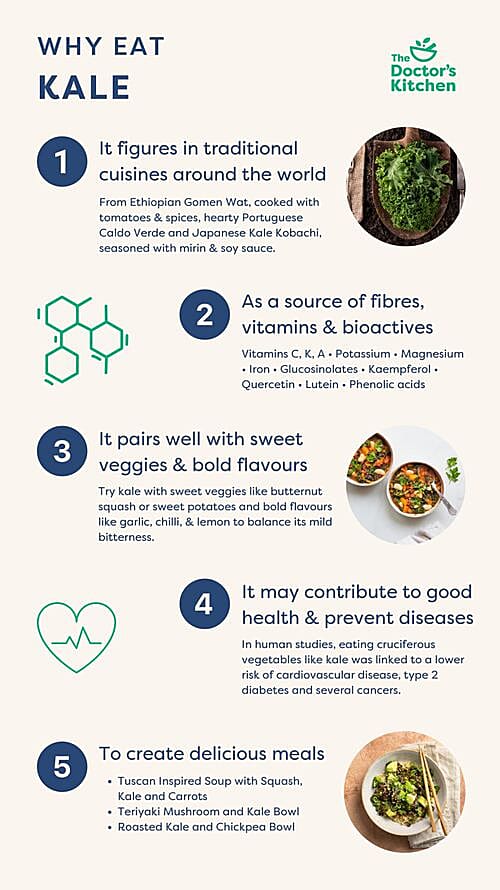Kale
17th Feb 2023
In this article: the fascinating science behind kale's potential health benefits, its origin and delicious ways to enjoy this leafy green that will make your taste buds dance!
Key points
Kale is a dark leafy green vegetable belonging to the Brassica family, also known as cruciferous vegetables. You can spot it in the shop by its long stem and wavy or frilly leaves.
⚡️ Quick Card

Save on Pinterest or download
Back in time: Origin & Traditional uses
The first known kale sightings were in the eastern Mediterranean and Asia Minor regions, around 2000 BC. The famous ancient Greek botanist Theophrastus wrote about it in 350 BC, solidifying its place in history.
In traditional medicine, leafy Brassica vegetables were used as a treatment for many ailments such as gastritis, gastric ulcer, rheumatism, bone weakness, ophthalmologic problems, hepatic diseases and anaemia. (Šamec et al. 2019)
Key compounds & Mechanisms of action
Kale contains a complex set of hundreds of nutrients and bioactive compounds that show health-supporting effects.
Nutrients include:
- Dietary fibres
- Vitamins C, K, A and B vitamins
- Minerals like potassium, magnesium, calcium, & iron
Bioactive compounds include:
- Glucosinolates – sinigrin & progoitrin/glucobrassicin
- Flavonoids – kaempferol & quercetin
- Carotenoids – Lutein, zeaxanthin and β-carotenes
- Phenolic acids – sinapinic, caffeic & ferulic acids
More than just a list: These compounds interact in complex ways. If extracted or turned into products like supplements or snacks, they are unlikely to have the same effects.
Special highlight: Glucosinolates
As a cruciferous vegetable, kale is particularly known for its glucosinolates – a unique group of compounds. They are inactive in the whole plant, but after cutting or chewing they are broken down into an active group called isothiocyanates. These are proposed to be important contributors to the health benefits of these vegetables. That’s because they show health-promoting effects in laboratory models, such as:
- Regulating inflammation and oxidative stress by modulating the activity of transcription factors like Nrf2 and NF-κB. These control the expression of antioxidant genes and inflammatory messengers.
- Promoting the excretion of carcinogens and toxic molecules by regulating detoxification enzymes
- Inhibiting the proliferation of cancer cells
Human studies
Multiple observational studies tracking people’s diets over time found that participants with higher intakes of cruciferous vegetables had a lower risk of:
Cardiovascular disease
Eating more leafy greens was associated with a 15.8% lower risk of heart disease, as per a meta-analysis. (Pollock et al. 2016)
Type 2 diabetes
Those who ate more cruciferous vegetables had a lower risk of type 2 diabetes. (Wang et al. 2016; Jia et al. 2016)
In the short term, one intervention study found that adding kale and other brassica vegetables to people’s daily diets improved insulin sensitivity and glycemic control. (Thorup et al. 2021)
Several cancers
A higher intake of cruciferous vegetables was associated with a reduced risk of colon, breast, ovarian, gastric and pancreatic cancers. (Tse et al. 2014; Liu X et al. 2013; Han et al. 2014; Wu et al. 2013; Li et al. 2015)
How much?
It’s hard to know exactly how much kale and other cruciferous vegetables may provide health benefits. Studies don’t always define what they mean by “higher intake” and doses vary. Usually, we found positive results associated with eating cruciferous vegetables at least once a week or almost every day.
Our advice:
- Regularity – What these studies have in common is consistency. They found results for a few portions of greens every week or every day.
- Meet yourself where you are – Start by adding a few portions of kale and other leafy greens to your weekly meals, like in a stew or stir-fry, alongside a variety of veggies.
- One 80g portion is 4 heaped tablespoons of cooked kale.
- Diversify and mix it up. Alternate between kale, cauliflower, cabbages, watercress, bok choy and all the other cruciferous veggies you find.
Nutrition research is challenging
These results show an association but do not prove causation and come with many limitations. So it’s hard to determine whether an ingredient can influence a condition.
Overall: Combined with lab studies and strong evidence about vegetables in general, these results suggest that kale is a good addition to our weekly meals.

Flavour & cooking: How to enjoy kale
When shopping for kale, look for locally sourced to support local farmers if you can. Find your nearest Community Supported Agriculture farm.
Around the world
Kale is used as a deliciously versatile vegetable by Michelin-starred chefs and figures in traditional cuisines around the world:
- German Grünkohlfahrt – A hearty dish of kale cooked with sausage
- Ethiopian Gomen Wat – Kale cooked with onions, tomatoes, ginger, garlic & spices
- Portuguese Caldo Verde – A hearty soup which combines kale, potatoes, & chorizo
- Japanese kale Kobachi – Kale sautéed lightly seasoned with mirin & soy sauce
Too bitter for you? Kale’s bitter taste can be attributed to its glucosinolates. But don’t let that stop you. With a little creativity and some tasty recipes, you can enhance its flavour and make it a delicious addition to your meals.
Kaleventure: Explore the many Kale varieties to find your favourite. If you want a sweeter and mild flavour, try Red Russian Kale. You’ll also find Cavolo Nero, curly kale, and more.
Steam it: When you can, choose steam cooking to preserve a higher amount of bioactive compounds. (Murador et al. 2016)
My favourite ways to enjoy kale:
- Massage it with sea salt in a bowl to break down the fibres, making it sweeter and softer
- Season it with olive oil, garlic, salt & pepper. Steam, boil or sauté in a pan for a few minutes. Add a splash of lemon juice and enjoy it as a quick veggie side.
- Stir-fry with soy sauce and mirin.
- Pair it with sweet veggies like butternut squash & sweet potatoes and bold flavours like garlic, chilli, & lemon.
- Add it to flavourful dishes like sauces, soups, stews and risottos at the end of cooking.
Try my Butter Bean, Mushroom and Kale Curry on the website.
We have more recipes tailored to your health goals with step-by-step images on the Doctor’s Kitchen app. You can try it for free and there is a free category too. Coming soon on Android. Some of my go-to’s with kale:
Teriyaki Mushroom and Kale Bowl
Tuscan Inspired Soup with Squash, Kale and Carrots
Found this interesting?
This was taken from our brand new newsletter called Seasonal Sundays. Every week, you receive ingredient highlights like this one in your inbox every Sunday. Click here to subscribe + get a free 7-day meal plan.
Dive deeper
Mechanisms: Esteve et al. Front. Nutr. 2020
Compounds: Satheesh et al. Cogent Food & Agriculture. 2020
Cooking: Murador et al. Food chemistry. 2016
Cancer prevention: Tse et al. Nutr Cancer. 2014 – Liu X et al. The Breast. 2013 – Han et al. Diagn Pathol. 2014 – Wu et al. Cancer science. 2013 – Li et al. World J Surg Onc. 2015
Type 2 diabetes: Wang et al. Journal of diabetes investigation. 2016 – Jia et al. Primary Care Diabetes. 2016 – Thorup et al. Nutrients. 2021
Cardiovascular disease: Pollock et al. JRSM Cardiovascular Disease. 2016
Origin: Šamec et al. Critical reviews in food science and nutrition. 2019
- Access over 800 research backed recipes
- Personalise food for your unique health needs
